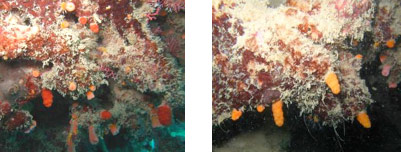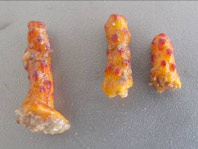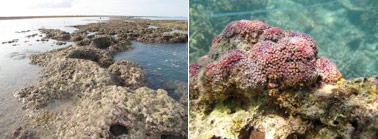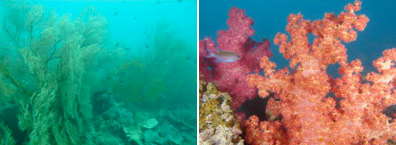Researchers' Diaries
Dr. Monika Schlacher-Hoenlinger
Marine Zoologist, Sessile Marine Invertebrate Section, Queensland Museum
Kimberley Coastal Octocorallia (Soft Corals and Sea Fans)
Another two weeks on the Kimberley Quest in Western Australia has come and gone.
This was the second trip to the Kimberley region for me as a member of the project team, providing yet another exciting chance to collect soft coral samples from Western Australia. We sampled the reefs around Cassini Island and Long Reef in the Eastern Kimberley. This is a remote region and this trip offered an opportunity to discover any possible new species - there is still so much left to discover and describe.
As an octocoral taxonomist, I was on board the Kimberley Quest as part of a team of museum scientists, which included a network of researchers engaged in a long term initiative to assess and explain the diversity, distribution, and abundance of marine life in the oceans. The Australian Biological Resources Study (ABRS) are funding a resurgence in Australia’s taxonomic capabilities for Octocorals and as such the Queensland Museum (QM) aims to comprehensively document the tropical Octocorallia fauna of the Australian east and west coasts. To date, about 1000 specimens from the Great Barrier Reef on the east coast have been collected by QM, but only about 250 soft corals from the west coast. The understanding of the Western Australian soft coral fauna had been long neglected and scientific understanding of the fauna in the Kimberley region is still very rudimentary. The ABRS/QM project dovetails with this current WA Museum Kimberley project by extending the opportunities to explore and record Australia’s Octocoral fauna.
Around Cassini Island, 16 visual surveys were undertaken using SCUBA, as well as two intertidal surveys. In the Long Reef region, 12 visual surveys were undertaken using SCUBA and six intertidal transects were investigated. Each survey consisted of three 5 m long transects and an investigation time of 50 min. If time permitted, the remaining dive time was used for further biodiversity investigations around the transect areas and noted separately.
In this survey, a total of 194 soft coral specimens were collected, belonging to 10 families, 41 genera, and 81 species. Soft coral diversity was clearly higher at Cassini Island, with 60% of all species coming from this region. Only 13% of species were collected only from Long Reef, whereas 27% of all species were found at both locations. Over 50% of species are possibly new to science, with 66% of new species accounted from Cassini Island, 18% from Long reef, and 16% of new species found at both locations.
Changes in both abundance and diversity noted between Cassini Island and Long Reef could be partly explained by the deeper average sampling depth at Cassini Island. Higher exposure times for the animals, in addition to increased turbidity and wave action, at Long reef seem to be the main contributing factors for the decreased biodiversity in this region. These results go hand in hand with the findings from last year’s expedition to Adele Island and Montgomery Reef. Although species richness of soft corals in the 2009 survey was much lower than in this survey (survey 2009: 37 species; survey 2010: 81 species), the picture of Octocorallia distribution remains the same. Island sites (Adele Island, Cassini Island) are distinctly more diverse than the shallower, more exposed reef sites (Montgomery Reef, Long Reef).
Nevertheless, despite that the harsher conditions on Long Reef resulting in decreased biodiversity, the environment also provides habitats for some uncommon species, such as colonies of Paraminabea and Eleutherobia (Fig. 1). Octocorallia of these genera are not very speciose in shallow waters, and are restricted to caves and overhangs. Only two species of Eleutherobia were so far recorded from Western Australia, with a new species being currently described from this survey (Fig. 2). The paratype of this new species of Eleutherobia is the first specimen of this genus housed in the Qld Museum collection. The holotype will be stored at the Museum of Western Australia.
Another exciting finding was the extreme high abundance of the encrusting “organ pipe coral”, Tubipora, on the western side of Long Reef. These massive colonies of Tubipora cover large areas especially on the edges of the exposed fore-reef ramps, and provide important habitats for other invertebrates and small fish (Fig. 3; see also the “Discovery” tab on this website for the article, ‘Organ Pipe Coral Flourishes at Long Reef – by Dr. Zoe Richards & Dr. Monika Schlacher-Hoenlinger’).
The reefs at Cassini Island were clearly more diverse than Long Reef, with astonishing growth of large sea fans and sea whips, as well as many species of Dendronephthya and Scleronephthya (Family: Nephtheidae) (Fig. 4).
More detailed laboratory examination of the specimens is necessary before the final identifications can be confirmed, but the preliminary results underpin the belief that the west coast of Australia harbours a unique octocoral fauna. Further and continuing scientific investigation on the biodiversity of the region will enhance our understanding of these unique environments.

- Fig. 1. Groups of Paraminabea sp. under overhangs at Long Reef in the Kimberley region.

- Fig. 2. A new species of Eleutherobia sp. found in a cave at Long Reef, Eastern Kimberley.

- Fig. 3. Massive colonies of Tubipora sp. on an intertidal reef flat on the western side of Long Reef, Eastern Kimberley.

- Fig. 4. Big sea fans and colourful species of Dendronephthya are typical sites around Cassini Island, Eastern Kimberley.








